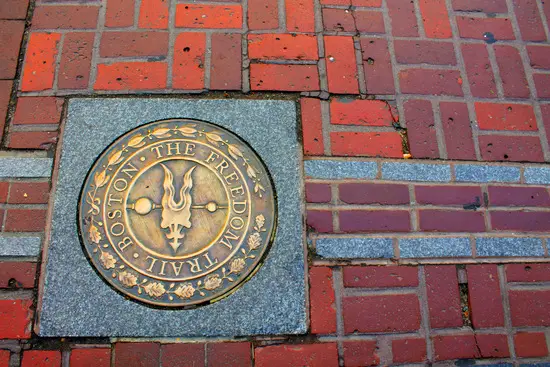2.5 Mile Trail that’s Packed with American Revolutionary History
Learn the history of the American Revolution with Boston’s famous 2.5 mile red-brick Freedom Trail. You’ll pass by more than a dozen important historic sites, most of which are free to experience. So lace up your walking shoes and get exploring this unique collection of museums, churches, buildings, and more.
About the Freedom Trail
The idea of the Freedom Trail was the idea of local journalist William Schofield who wanted there to be a pedestrian friendly route that took in Boston’s incredible local landmarks. You can hit the trail on your own self guided journey or book one of many guided tours that are led by 18th-century costumed guides. There are several different themed day tours, a night lantern tour, and even a pub crawl tour.
You will find it easy to follow the trail because it is laid out as a special red brick path on the sidewalk from the start to the end of the trail. The trail is conveniently marked at intersections, so you won’t get lost or lose the trail. You will find the local Bostonians to be very friendly and will more than likely be willing to offer you helpful pointers about various stops along the trail.

Things to See and Do Along the Freedom Trail
Luck of the Irish
People of Irish descent form the largest single ethnic group in Boston. While travelling in Boston, you might want to see if the luck of the Irish is in your favor by checking out the city’s numerous casinos. The city is set to become the home of a five-star urban waterfront gaming resort with a lovely harbor walk. In the meantime, an easier alternative for when you want to play casino games, you can do so online where you can also access free casino bonuses.
Boston Common
Many visitors use this landmark as the starting point to their Freedom Trail journey. You can plan the entire journey to take anywhere between a half day to a full day depending how much time you spend at each site. Boston Common is the oldest city park to be found in the United States. The area was once used as a camp by the British before the American Revolutionary War and later would become a grazing area for livestock and military training ground. The park has also seen famous names such as Martin Luther King Jr. give speeches there.

Massachusetts State House
Admire and take an inside tour of the seat of Massachusetts government which dates back to the late 18th century. Designed by architect Charles Bulfinch, it is considered a masterpiece of Federal architecture. Across the street at the northeast corner of the commons is the Massachusetts State House. Paul Revere owned the land and grazed his cattle there.

Park Street Church
This active church has been welcoming worshippers for over 200 years. It was once used as a storage place for gunpowder during the War of 1812 and it is said that the famous song “My Country ‘tis of Thee” was sung here first in 1831.It was also an important venue for protesting slavery and supporting women’s suffrage.
Granary Burying Ground
Founded in 1660, the Granary Burying Ground is Boston’s third oldest cemetery. The cemetery marks the final resting place for Revolutionary War patriots like Paul Revere as well as Declaration of Independence signers Samuel Adams and John Hancock. The cemetery has over 2,300 tombstones and grave markers but it is believed that there may be more than double that number buried here.

King’s Chapel and Burying Ground
Witness the oldest continually used pulpit in the United Sates by visiting King’s Chapel. It is considered Boston’s first Anglican church. The nearby burying ground predates the 18th century church by more than a century and is the final resting place for several American Revolution war heroes. It is also where you will find the burial place of the first European woman to step ashore in New England, Mary Chilton.
Boston Latin School
The oldest public school in America, Boston Latin School was founded in 1635. Its very existence puts to rest the denunciations of the colonists as rubes. Benjamin Franklin, Robert Treat Paine, William Hooper, Samuel Adams, and John Hancock, all signers of the Declaration of Independence had attended the Latin School.
It is easy to forget, given how big New York City is today, that in revolutionary times Boston was the center of rebellion against the Crown and, along with Virginia, was one of the two most prominent states.
Old Corner Book Store
Be sure to check out the building that was once Boston’s oldest commercial building, being the center of American publishing during the 1800s. The building which was saved from demolition in the 1960s produced Thoreau’s famous Walden, The Scarlet Letter, and Midnight Ride of Paul Revere. The building is now a Chipotle Mexican Grill if you need a bit of energy for continuing on with the trail.
Old South Meeting House
The meeting house was a place of worship for Puritans who didn’t choose to call it a church. It was also the site of many revolutionary meetings, most notably the meeting that led to the Boston Tea Party. Just across the street you will find Benjamin Franklin’s birthplace, 1 Milk Street.
Old State House
The Old State House has withstood massacre, revolution, and fire to remain the oldest surviving public building in Boston. The Declaration of Independence was read from one of the building’s balconies and the State House was home to the offices of the British Governor of Massachusetts when it was built in 1713. The Old State House offers a museum of fascinating artifacts dating back to colonial times and the Revolutionary War.

Boston Massacre Site
A memorial to the colonists who lost their lives in the Boston Massacre is in front of the Old State House. The Boston Massacre began as a simple act of disrespect from one British soldier to one colonist. It occurred in March 1770. Bostonians began throwing snowballs at the British and the contretemps snowballed out of control from there.
Faneuil Hall
America’s first Town Meeting was hosted here and is often referred to as the Cradle of Liberty. Notable names such as Samuel Adams encouraged independence from Great Britain from this location. A marketplace since the mid 18th century, Faneuil Hall offers an indoor/outdoor mall with restaurants.

Paul Revere’s House
In the first decade of the 20th century, Boston was undergoing an urban development boom and a certain very old structure was to be torn down for a modern building. Citizens realized that the building in question was Paul Revere’s house and fought to have it named an historical site which it is today.
The house is tucked very conspicuously between two modern buildings. The tour of the building is extremely interesting as it shows how life was back in the 18th century.

Old North Church
This is the oldest church in Boston, dating back to 1723. It is notable for it being where the “One if by land, two if by sea” signal is said to have been sent during Paul Revere’s famous midnight ride. Lanterns were placed in the church’s tower.
Copp’s Hill Burying Ground
Not an official stop on the Freedom Trail when it was created, this burying ground has become a more recent stop for visitors. The site once saw British fire cannons during the Battle of Bunker Hill and is the final resting place for many merchants and artisans of the era.
Bunker Hill
The battle that was waged on this hill was the first major battle of the Revolutionary War. The monument is visible from quite a distance away. You can climb the stairs to the top but note that it may be a bit of a workout for some. The steps are steep and are narrow in width, so people coming down will be in the way of people going up and vice versa.
USS Constitution
This often marks the end of the Freedom Trail unless you use this as the starting point and work your way to Boston Common. Here you can see the world’s oldest commissioned naval vessel still afloat. Named by President George Washington, the USS Constitution was launched in 1797 and used during the War of 1812. The ship would be nicknamed “Old Ironsides” and now offers a fascinating museum.




















